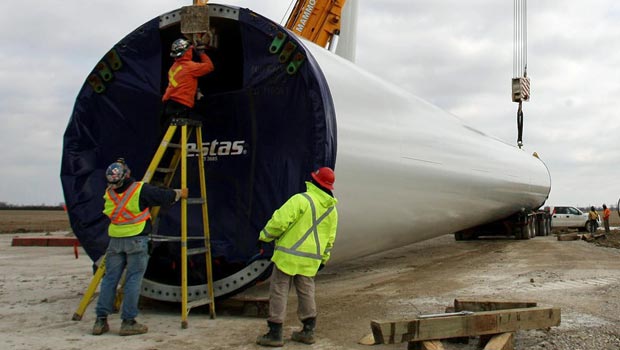As gas prices plummet and many O&G workers face unemployment in the upcoming year, a new report has charted the transition from oil and gas to green energy in Canada. Better prospects for jobs–sun, wind and water are more widely distributed across the nation than oil fields–and clean energy business opportunities exist in many areas that have so far not been exploited, according to Clean Energy Canada, which undertook the research. Communications Director James Glave explained some of the details about when and how the fast-approaching energy revolution will happen, as well as about the remaining questions–and challenges–of the new frontier.
“Canada-wide, working class citizens travel to oil and gas areas to work in industry. Looking at the two energy industries–oil and gas and clean energy–what is their future with regards to employment,” James Glave, communications director at Clean Energy Canada, told The Speaker.

Glave commented specifically on the future of Canadian employment in the two markets–oil and gas and clean energy.
“Oil and gas jobs are inextricably tied to the physical locations of fossil-fuel deposits; resource sector families have long struggled with the separation of loved ones, who travel to and from work in often-remote camps,” said Glave.
“While renewable-energy project sites are similarly often also located in remote sites–as an example, I’d cite the Forest Kerr run-of-river project in remote northwestern British Columbia–clean-energy resources such as wind, sun, and water are distributed widely across the country. Opportunities exist for building and maintaining clean-energy generation from coast to coast to coast. Further, beyond putting iron in the ground, the opportunities to innovate clean energy products and services–for example, energy efficiency control software–exist anywhere, but to date have largely centred around clean tech ‘clusters’ in Vancouver, Toronto, Montreal, and Halifax.”
Clean Energy Canada’s report, “Tracking the Energy Revolution: Canada,” found that people working for green energy companies already outnumber those who work in the so-called tar sands. In the last five years, $25 billion has been invested in the sector, and green energy work has risen 37 percent.
Capacity and sales are up as well. Solar, wind, river and biomass plant power is up 93 percent since 2009, and electric vehicle sales doubled one year (2012-2013), to list just two notable examples from the organizations findings.
However, there is no real choice between the two sectors. The future of energy is clean, and it is really a matter of when and how, according to Glave.
“The transformation of Canadian and global energy systems is inevitable,” he said. “As to when, the answer is some combination of what is possible and what is necessary.”
He spoke of Canadian energy potentials.
“On the what’s possible side, we turn to the work of Stanford University’s Mark Jacobsen. His team’s work demonstrates that on a global basis, it is possible to produce all new energy with wind, water, and solar by 2030, and possible to replace all existing energy with these sources by 2050. ‘Barriers to the plan are primarily social and political, not technological or economic,’ he writes ‘The energy cost in a wind, water and sun world should be similar to that today.’ We don’t yet have the modelling in place to confirm what specifically this means for carbon-rich Canada, but we do know that we need a plan to manage this transition to minimize economic and employment disruption.”
“As for the necessary date, the United Nations Environment Programme recently pegged it at 2070. That is the year by which the Intergovernmental Panel on Climate Change confirms that the world must cut net CO2 emissions from fossil fuel combustion to ZERO if humanity is to avoid ‘severe, pervasive and irreversible impacts for people and ecosystems.’ By the end of this century, ALL greenhouse gas emissions–including methane, nitrous oxide and ozone, as well as CO2–must fall to net zero or even go negative, the UN says.”
Glave provided some analysis on what Canadians should be aware of with regard to the funding of the clean energy revolution.
“Canada’s fossil fuel sector has generated and continues to generate tremendous wealth,” noted Glave. “Other oil-rich nations, particularly Norway, have done an excellent job of setting aside proceeds from oil revenues; Norway now has a near-trillion-dollar nest egg that will likely help that nation with this inevitable economic transition. Canada has not done this, though our polling suggests that strong public support exists for such an idea. It’s going to be tough to catch up and embrace a Norway-style at this late date, so the funding will likely be some combination of financing from the growing private-sector investment and targeted public support–the same kind that got the oil sands off the ground many years ago.”
References:
